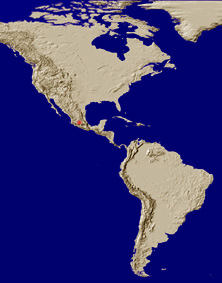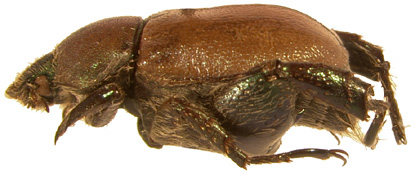 |
|||||||
|
|||||||
Parachyrsina Bates, 1888
Parachrysina truquii
photo by Matthew R. Moore
distribution of Parachrysina species
Parachrysina truquii
photo by Matthew R. Moore
|
||
| Rutelinae Taxa Map | ||
| Rutelini Taxa Map | ||
| Rutelinae Key | ||
| Rutelini Key | ||
| Areodina Key | ||
| Areodina Gallery |
Diagnosis: Parachrysina is distinguished from the other Rutelinae and Areodina by the following combination of characters: (1) 8-9 segmented antennae, (2) venter with setae (except middle of metasternum which has a fovea), (3) protibia with three external teeth, (4) metafemur clearly enlarged in males (except P. borealis), (5) color testaceous with dark green or entirely dark green (Deloya and Morón 1988; Jameson 1991).
Distribution: Parachrysina occurs from northeastern Mexico (Neuvo León) south to the Tranverse Volcanic Belt, the southern Sierra Madre Occidental, and the interior slope of the southern Sierra Madre Occidental (Jameson 1991).
Composition: The genus Parachrysina contains six species: P. amadomartinezi Deloya and Morón, 1988; P. batesi Deloya and Morón, 1988; P. borealis Jameson, 1991; P. mazatli Deloya and Morón, 1988; P. parapatrica Deloya and Morón, 1988; P. truquii (Thomson, 1857).
Biological Data: The biology of Parachrysina is not well documented in literature. Females are rarely collected, and only the males of P. truquii and P. parapatrica have been observed in the wild. Male P. truquii are diurnal, and they tend to be found in tropical deciduous forests of the southern Sierra Madre Occidental (Deloya and Morón 1988). Male P. truquii have been collected on the leaves and flowers of Euphorbiaceae, Asclepiadaceae, Verbenaceae, and Leguminaceae in September (Deloya and Morón 1988). Female P. parapatrica have been collected on Solanum sp. (Solanaceae) during July (Deloya and McCarty 1992).
References:
Deloya, C., and J.D. McCarty. 1992. Descripción de una nueva especie de Aphodius (Coelotrachelus)(Aphodiinae) y de la hembra de Parachrysina parapatrica (Rutelinae) (Coleoptera: Lamellicornia).
Deloya, C., and M. A. Morón.1988. Descripcion de quatro especies de Parachrysina Bates (Coleoptera: Melolonthidae, Rutelinae). Folia Entomológica Mexicana 76: 129-150.
Jameson, Mary Liz. 1991. A new species of Parachrysina Bates (Coleoptera: Scarabaeidae: Rutelinae) from Nuevo León, Mexico. Coleopterists Bulletin 45(3): 232-238.
|
||||
|
|


